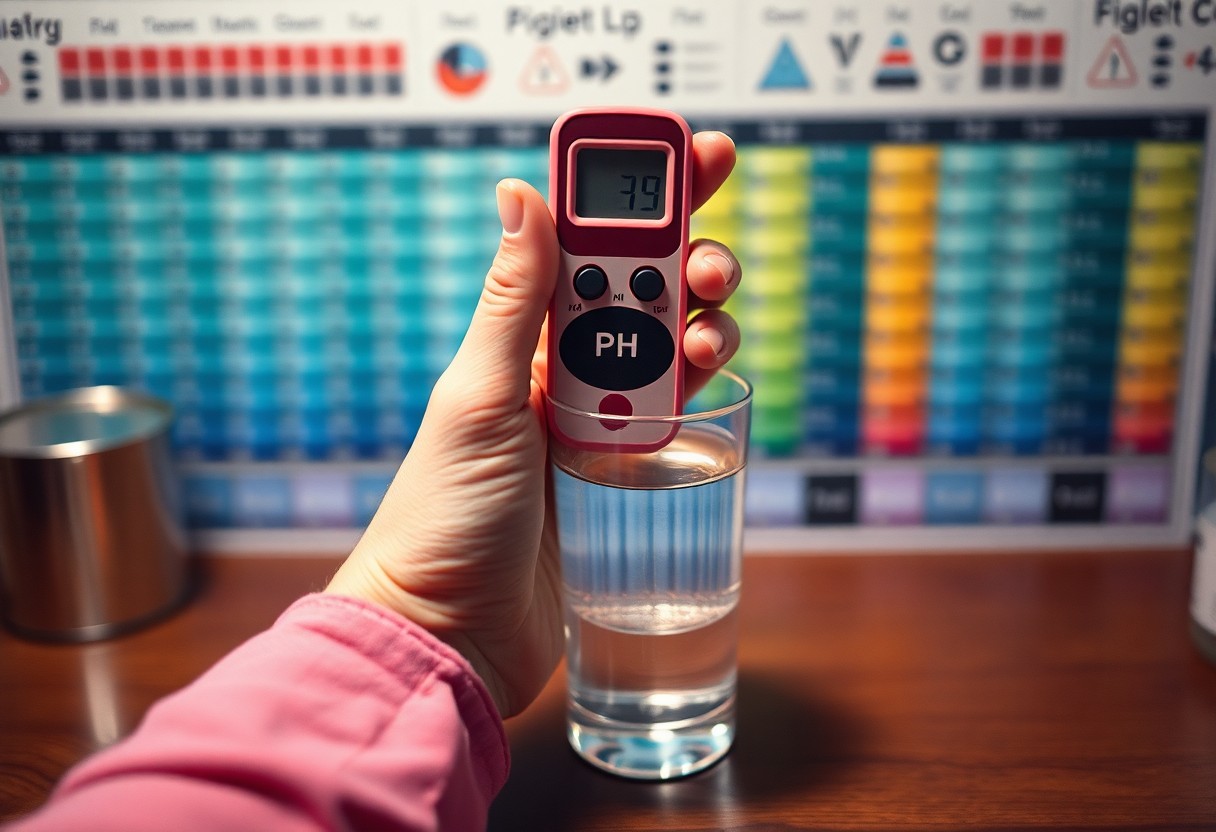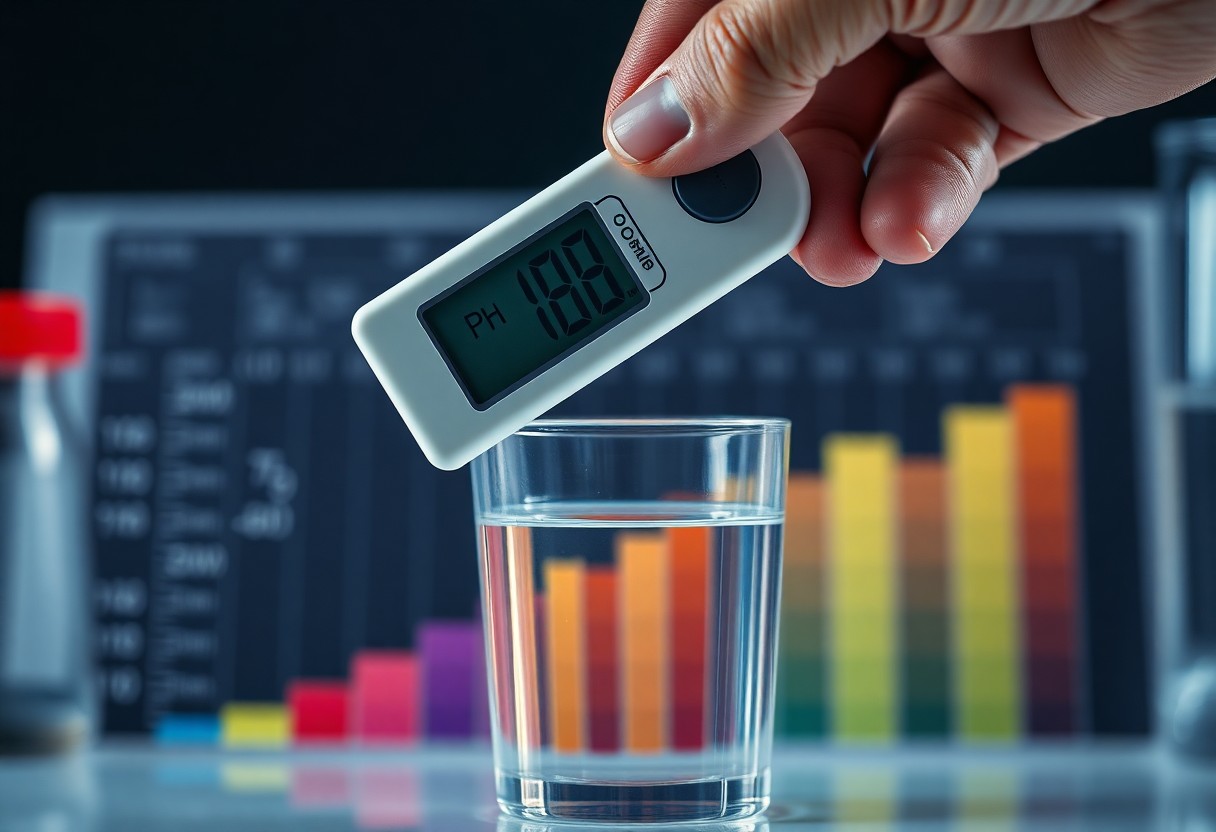Check the pH of your water to ensure it meets safety standards and supports your health. Understanding the pH level is necessary since acidic or alkaline water can negatively affect your plumbing, garden, and even your health. In this guide, you will learn how to accurately test the pH of water using simple methods and tools, empowering you to take control of your water quality and make informed decisions for your home or garden.
Table of Contents
Key Takeaways:
- pH Meter: Use a digital pH meter for the most accurate measurement of water pH levels.
- pH Test Strips: Affordable and easy to use, pH test strips can provide quick results for water acidity or alkalinity.
- Calibration: Always calibrate your pH meter or test kit with standard solutions to ensure reliable readings.
Understanding pH Levels
Your understanding of pH levels is vital for assessing water quality. The pH scale ranges from 0 to 14, indicating how acidic or basic a substance is. A pH of 7 is neutral, while values below 7 signify acidity, and those above indicate alkalinity. Knowing the pH level helps you determine the potential impacts on health, aquatic life, and soil quality.
What is pH?
Even though pH is often overlooked, it plays a significant role in chemistry. It’s a measure of hydrogen ion concentration in a solution, and it indicates the acidic or alkaline nature of that solution. Understanding this concept helps you make informed choices regarding your water quality.
Importance of pH in Water
Water pH can affect not only your health but also the well-being of aquatic ecosystems. A balanced pH level is vital for safe drinking water and supports biodiversity.
Understanding the importance of pH in water is vital for maintaining healthy drinking water and supporting aquatic life. Water with a pH below 6.5 can corrode pipes, potentially introducing harmful heavy metals into the water supply. Conversely, water with a pH above 8.5 can lead to mineral build-up and impact taste. Regularly checking the pH level ensures that your water remains safe for consumption and helps maintain ecosystems in lakes and rivers.

How to Measure pH of Water
Assuming you want to accurately assess the pH level of your water, you have various reliable methods at your disposal. Each method offers its own advantages, allowing you to choose one that fits your needs and expertise. Whether you prefer the simplicity of pH test strips or the accuracy of a digital meter, understanding how to measure pH effectively will enhance your water quality monitoring.
Using pH Test Strips
Even with their simplicity, pH test strips are a great tool for measuring water pH. You simply dip a strip into your sample, wait a few seconds, and then compare the color change to the chart provided. This method offers quick results and is particularly useful for casual users or those new to measuring water chemistry.
Using a Digital pH Meter
If you’re looking for a more precise measurement, a digital pH meter is your best option. This device provides an exact pH reading, which is especially beneficial for tasks that require accuracy, such as in scientific experiments or sensitive aquatic environments.
Using a digital pH meter involves first calibrating the device with standard solutions to ensure accuracy. Then, you simply immerse the electrode in your water sample and wait for the reading to stabilize. Ensure you clean the electrode regularly to obtain reliable results. This method is preferred for precise measurements, but be cautious as poor maintenance can lead to inaccurate pH readings. Always refer to the manufacturer’s instructions for the best practices in care and usage.

Tips for Accurate pH Testing
Now that you are equipped to measure the pH of water, consider these tips for accurate results:
- Always clean your instruments before measurements to avoid cross-contamination.
- Stir the sample gently to ensure consistent pH readings.
- Test at the same temperature for comparability.
- Use freshly calibrated meters or strips for reliable results.
This will enhance the precision of your pH testing process.
Calibration of Instruments
With proper calibration, your pH meter can yield the most accurate readings. Regularly calibrate your devices using standard buffer solutions, which serve as reference points for your measurements. Follow the manufacturer’s guidelines for best results, ensuring that you account for temperature variations during calibration.
Sample Preparation Techniques
Tips for preparing your water sample include proper filtration and stabilization. Before testing, make sure to filter out any sediments or particulates that may affect your results. Allow the sample to stabilize to room temperature to avoid any discrepancies from temperature variations.
For instance, if you’re testing water collected from a natural body, filtering out leaves and debris is crucial to obtain an accurate pH reading. Furthermore, allowing the sample to rest for a short period ensures that it has stabilized, preventing any fluctuations caused by temperature changes or dissolved gases. Skipping these steps may lead to misleading results, ultimately affecting your analysis or treatment decisions.
Factors Affecting Water pH
Despite the importance of checking water pH, several factors can influence its levels. Understanding these influences helps in maintaining optimal water quality. Key factors include:
- Source of Water
- Temperature
- Presence of Minerals
- Pollution
After knowing these factors, you can better assess your water’s quality.
Natural Influences
Some natural influences on water pH include the decomposition of organic matter, rainfall, and the presence of various minerals in the soil. These elements naturally interact with water and can either increase or decrease its acidity. Therefore, understanding the geological characteristics of your area can help you predict pH levels.
Human Impacts
On the other hand, human activities significantly affect water pH levels. Industrial discharges, agricultural runoff, and urbanization often lead to increased acidity, impacting overall water quality and aquatic life.
Impacts from human activities can vary tremendously, resulting in dangerous pH shifts that harm ecosystems. For instance, acid rain, induced by industrial pollutants, can lead to severely low pH levels, endangering fish and plant life. While some initiatives aim to mitigate these impacts, such as monitoring emissions and fostering sustainable practices, the balance remains delicate. Consequently, your awareness and action can contribute significantly to preserving and improving water pH levels in your environment.
Interpreting pH Results
Keep in mind that pH values range from 0 to 14, with 7 being neutral. A pH below 7 indicates acidic water, while a pH above 7 signifies alkaline water. Understanding these results is necessary for both your health and the performance of your plumbing systems. For instance, highly acidic water can corrode pipes, while overly alkaline water may hinder the effectiveness of disinfectants.
Safe pH Levels for Drinking Water
You should always aim for a pH level between 6.5 and 8.5 for drinking water. Within this range, the water is generally considered safe and palatable. Levels outside this range could lead to either health concerns or unpleasant tastes. Regular testing can help ensure your drinking water remains within this optimal pH range.
Implications of Extreme pH Levels
An extreme pH level can severely impact your health and the safety of your drinking water. Water with a pH lower than 6 or higher than 8.5 can pose risks such as skin irritation and weakened immunity. Additionally, acidic water can leach harmful metals from pipes while alkaline water might interfere with nutrient absorption in your body.
Levels below 6 may introduce heavy metals like lead and copper into your drinking water, which can lead to serious health issues, including neurological problems. Conversely, levels above 8.5 can affect the water’s taste and potentially alter your digestive system’s efficiency. By monitoring and adjusting the pH levels of your water, you can safeguard against these adverse effects and ensure a healthy water supply.
Troubleshooting Common Issues
Many users encounter challenges while testing the pH of water. These issues can stem from various sources, including equipment malfunction or incorrect usage. By identifying and addressing these common problems, you can ensure accurate readings and maintain your monitoring process effectively.
Inconsistent Readings
Readings can sometimes be inconsistent due to factors such as temperature fluctuations or contamination of the probe. Make sure your testing environment is stable and that the equipment is clean to avoid inaccuracies.
Equipment Maintenance
With regular maintenance, your pH testing equipment can function optimally. This includes cleaning the probe and recalibrating the device as specified by the manufacturer. Proper care extends the lifespan of your equipment and ensures reliable measurements.
Troubleshooting your pH testing equipment begins with understanding its maintenance needs. Frequent cleaning of the probe with a suitable solution can prevent buildup of foreign substances that may affect performance. Additionally, recalibrating your pH meter according to the manufacturer’s recommendations will improve accuracy. Neglecting these practices can lead to errors in your readings, potentially resulting in misguided decisions regarding water treatment. By prioritizing these steps, you can maintain high accuracy and ensure you obtain correct pH values every time.
Final Words
As a reminder, checking the pH of your water is imperative for maintaining its quality and safety. You can easily achieve this using pH test strips or digital meters, ensuring you understand the acidity or alkalinity of your water source. Regularly testing helps you make informed decisions about water use and treatment. For a deeper understanding of pH and its significance for water quality, explore more in this article on Water Quality 101: What Is pH in Water Testing?.
Q: How can I check the pH of water using litmus paper?
A: To check the pH of water using litmus paper, you need to first obtain a package of pH test strips or litmus paper. Dip a strip into the water sample for a few seconds, then remove it and let it sit for a moment to allow the color to develop. After that, compare the resulting color of the strip to the pH chart that comes with the strips. This chart will help you determine the pH level by matching the color of your strip to the corresponding pH value.
Q: What tools can I use to measure the pH of water?
A: There are several tools available for measuring the pH of water. The most common options include pH test strips, digital pH meters, and liquid pH test kits. pH test strips are easy to use and provide a quick visual indication. Digital pH meters offer a more accurate and precise measurement, usually requiring calibration before use. Liquid pH test kits involve adding a few drops of a reagent to the water sample, which changes color based on the pH level. Choose the method that best suits your needs and level of accuracy required.
Q: Can I check the pH of water without any special equipment?
A: While specialized equipment like pH meters and test strips provide the most accurate results, you can perform a simple, though less precise, test using household items. For instance, you can use red cabbage juice as a natural pH indicator. Simply chop up red cabbage, boil it in water, and strain the liquid. When you add this juice to your water sample, it will change color depending on the pH level: it turns reddish in acidic solutions and greenish-yellow in basic solutions. This method can give you a rough estimate of the pH but is not as reliable as dedicated testing tools.